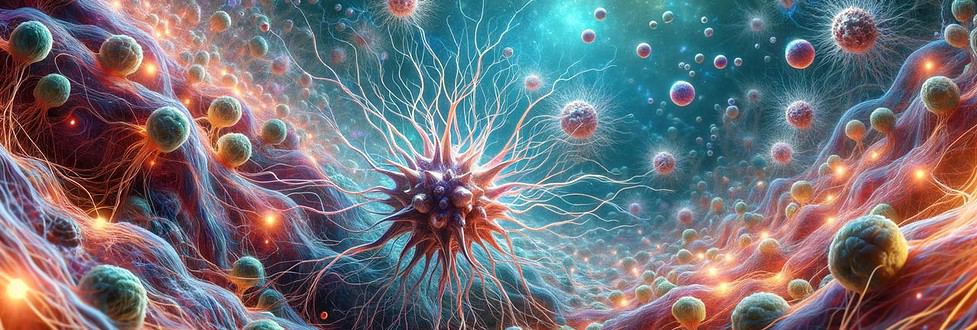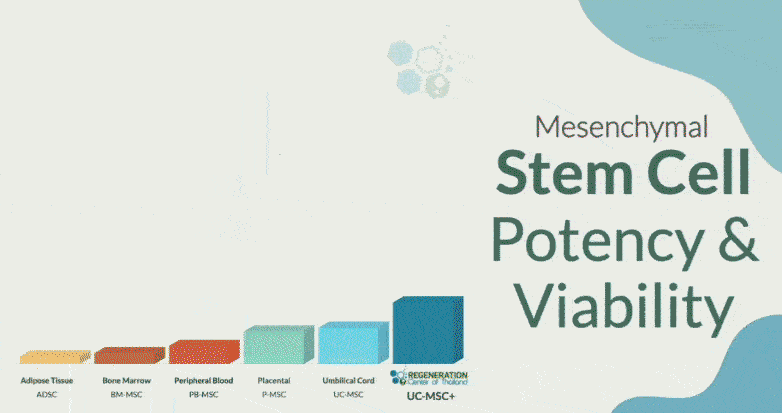MSC+ Stem cells are considered pluripotent and have the potential to convert into many cell types in the human body. These stem cells act as a repair system for the human body and can theoretically keep dividing without any limits to replenish other cells. When a Mesenchymal stem cell divides, each newly produced cell has the unique potential to either convert into a different type of cell or remain a stem cell. If needed these master cells can convert themselves to a very specialized function, such as stromal cells, skin cells, motoneuron cells, blood cells,muscle cells, neurotransmitter or a (neuron) brain cell.
NEURODEGENERATIVE DISEASES
The number of patients needing organ transplants far exceeds the total number of organs available which is why stem cells offer the unique possibility of an unlimited source of cells that can be grown in the lab to treat a wide variety of neurodegenerative diseases, aphasia, brain injuries and spinal cord injuries.
Understanding Neurological & Spinal Conditions
Understanding neurological and spinal conditions requires focusing on their causes, symptoms, and potential treatment options. Various factors, including genetics, can influence disease progression in these conditions. That’s right, your DNA can play a significant role in determining your susceptibility to such conditions. Diagnostic techniques for these conditions have advanced significantly over the years. Now, doctors can use sophisticated imaging and neurological tests to pinpoint the exact cause of your symptoms. These techniques don’t just help in diagnosis; they also aid in monitoring disease progression and gauging the effectiveness of treatment.
Patient experiences with these conditions can vary widely. Some may experience mild discomfort or occasional symptoms, while others may face debilitating pain or loss of function. It’s crucial to remember that each patient’s journey is unique, and what works for one may not work for another. The lifestyle impacts of neurological and spinal conditions can be profound. You should make significant changes to your daily routines, work, or recreational activities. But don’t lose heart. You can manage your symptoms and maintain a good quality of life with the proper treatment and support.
Current Treatment Landscape
Navigating through the myriad of current treatment options for neurological diseases, movement disorders and spinal conditions, you’ll find a continually evolving landscape. Technological and pharmaceutical advancements are revolutionizing the field, creating more effective treatment options.
Pharmaceutical advancements, in particular, have led to new drugs that can more effectively manage symptoms, slow disease progression, and, in some cases, even reverse damage. These new therapies aren’t just more effective and more personalized. Through the power of personalized medicine, doctors can customize treatments to bypass the blood-brain barrier based on your genetic makeup, ensuring that the treatment you receive is the most effective for your unique condition.

But it’s not just the pharmaceutical industry that’s making strides. Genetic therapies are also emerging as a promising new treatment option. By correcting or replacing faulty genes, these therapies can potentially treat and even cure certain neurological and spinal conditions. Global initiatives are also playing a critical role in this evolving landscape. By promoting research and collaboration worldwide, these initiatives are helping to accelerate the development of new treatment options.
However, as these new treatments become available, they also raise important insurance implications. Some of these cutting-edge therapies come with a high price tag, making it crucial to understand your insurance coverage and what it means for your treatment options. As you navigate this landscape, it’s important to remember that our understanding of these conditions and the treatment options are rapidly changing. It’s an exciting neurological and spinal care time, promising hope for those living with these conditions.
NEUROTRANSMITTERS
Recent Research Breakthroughs
In the realm of recent research breakthroughs, you’ll find many new findings paving the way for novel neurological and spinal treatment options. One of the most exciting areas of progress is gene therapy advancements. Scientists are making strides in using genes to treat certain neurological conditions, offering you a ray of hope for a future where conditions like Parkinson’s may be managed more effectively.
Telemedicine applications are also changing the face of treatment. With remote consultations becoming increasingly common, you can access expert advice and care from home. This is particularly beneficial for those with mobility issues or those living in remote areas. Next on the list is the development of AI diagnostic tools. These sophisticated technologies improve the speed and accuracy of neurological and spinal condition diagnosis. They’re helping doctors identify symptom patterns and make accurate predictions about disease progression.
Virtual reality rehabilitation is another area of breakthrough. It allows you to undergo physical therapy in a simulated environment, making exercises more engaging and effective. However, it’s not all smooth sailing. The use of stem cells in treating neurological conditions is still controversial. While some studies show promise, ethical concerns and potential adverse effects make it contentious.
In all, these breakthroughs are transforming the way neurological and spinal conditions are treated. They’re improving the quality of care and offering you better and potentially more effective treatment options.
Innovative Surgical Interventions
Building on these advancements, we now focus on innovative surgical interventions that revolutionise treatment approaches for neurological and spinal conditions. You’re about to discover how modern technology, including robotic-assisted surgeries and minimally invasive techniques, is transforming the landscape of neurosurgery and spinal treatment.
Robotic-assisted surgeries are at the forefront of this innovation. They allow surgeons to perform complex procedures with unprecedented precision and control. You’d be amazed at how it’s reducing recovery times and improving patient outcomes. In the same vein, minimally invasive techniques are gaining traction. They’re less traumatic to your body, so you’ll experience less pain and a quicker recovery.
SPINAL CORD INJURIES
Now, let’s talk about laser surgery advancements. Laser surgery has been a game-changer, especially for patients with spinal conditions. It’s allowing surgeons to target specific areas with high precision, reducing the risk of damaging surrounding tissues. You’ll appreciate how it’s making surgeries safer and more effective. Telemedicine in neurosurgery is another exciting development. It’s making healthcare more accessible, especially for those in remote locations. You can now consult with leading neurosurgeons from the comfort of your home. Imagine the convenience!
Lastly, let’s remember real-time imaging technology. It’s giving surgeons a live view of the surgical area, helping them make more accurate decisions during operations. You’ll be reassured that it’s enhancing the safety and success of surgeries. It’s an exciting time in neurosurgery and spinal treatment. These advancements are just the beginning. They’re paving the way for even more innovative surgical interventions.
Groundbreaking Non-Surgical Therapies
Now, let’s discuss new groundbreaking non-surgical therapies shaking up the neurology and spinal treatment world. Therapy advancements are rapidly changing, offering alternative therapies that are just as effective, if not more so, than conventional ones. One of these advancements is radiofrequency ablation, a procedure that uses heat to reduce or stop the transmission of pain in spinal nerves. Early studies suggest it’s highly effective, significantly improving treatment efficacy and reducing the need for invasive surgeries. It’s an exciting development, but it’s not the only one.
Next up is neuromodulation. It’s a therapy that alters nerve activity by delivering electrical or pharmaceutical agents directly to a target area. It’s been gaining traction for its potential to control various neurological conditions, from chronic pain to movement disorders. What’s more, it’s often a more accessible option. The devices are implanted during a simple outpatient procedure and can be adjusted to suit your needs.
But what do these advancements mean for your patient experience? Simply put, they offer you more choices and control over your treatment. You’re no longer limited to invasive procedures with long recovery times. Instead, you can opt for treatments that are less invasive, more accessible, and just as effective. These therapies are just the tip of the iceberg. As research progresses, we will likely see even more alternative therapies emerge. It’s an exciting time in the neurology and spinal treatment field, and you’re at the heart of it. You’re not just a passive recipient of care but an active participant in your treatment, with various effective, accessible options.
The Role of Regenerative Medicine
While we’re on innovative treatments, remember the impressive strides in regenerative medicine. This dynamic field holds promise for treating various neurological and spinal conditions. Stem cell treatment advancements are at the forefront of this revolution, which have brought about new treatment possibilities. These advancements are offering hope to patients who once had limited options.
Gene therapy potential is another exciting area of regenerative medicine. This technique uses genes to treat or prevent disease by inserting, altering, or removing them within an individual’s cells. Imagine a future where we can cure diseases by simply rewriting our genetic code! Now that’s a game-changer.
But it’s not just about genes or cells. Tissue engineering possibilities are opening up whole new avenues for treatment. By creating artificial organs in the lab, it’s hoped that we can overcome the shortage of donor organs. It’s like building spare parts for the human body. Cellular reprogramming techniques are also making waves. This involves changing the function of a cell so it can repair damaged organs or tissues. It’s like giving cells a new job description, significantly impacting how we approach treatment.
TREATMENT RISKS & PRECAUTIONS
Please note that not all patients are suitable candidates for treating neurological or spinal conditions with stem cells. Patients with severe nerve damage, advanced spinal degeneration, significant mobility issues, or other critical health concerns might not be good candidates for treatment.Future Prospects in Treatment Development
As we gaze into the crystal ball of future medical advancements, you might wonder what’s on the horizon for neurological and spinal treatment options. You’ll be thrilled that the future looks promising, with breakthroughs in telehealth advancements, genetic therapies, personalized medicine, nanotechnology applications, and virtual reality rehabilitation. We’ll soon have access to top-notch neurological care from home, thanks to telehealth advancements. Imagine consulting with your neurologist via a secure video call or monitoring your spinal health remotely. Isn’t that exciting?
Now, let’s talk about genetic therapies. Researchers are exploring ways to manipulate genes to treat neurological disorders. It’s like fixing a faulty wiring system. This means you could say goodbye to inherited neurological and spinal conditions in the future. Then there’s personalized medicine. Your treatment won’t be a one-size-fits-all approach anymore. Instead, doctors will tailor treatments based on your genetic makeup, lifestyle, and environment. It’ll be all about what works best for you.
Nanotechnology applications are also on the horizon. Tiny nanoparticles could deliver drugs directly to your brain or spinal cord injuries, bypassing the blood-brain barrier. This could make treatments more effective and reduce side effects. Virtual reality rehabilitation revolutionises recovery from neurological and spinal injuries. You can practice walking or moving your hands in a safe, virtual environment. It’ll make rehabilitation more engaging and effective.
From innovative surgical techniques to groundbreaking non-surgical therapies and the potential of regenerative medicine, there’s a lot of hope for the future.
Currently treatments and clinical trials are being offered for Alzheimer’s diseases, Parkinson’s, stroke, Ataxia, Cerebral palsy, Motor Neuron Disease, Amyotrophic lateral sclerosis
To learn more please contact us today.


